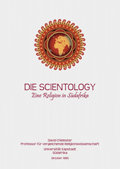1. Church of Scientology, A Description of the Scientology Religion (Los Angeles: Church of Scientology International, 1993): S. 2.
2. E. B. Tylor, Primitive Culture, 2 Bände (London: John Murray, 1920): I: S. 424; Emile Durkheim, The Elementary Forms of the Religious Life, übersetzt von Joseph Ward Swain (New York: The Free Press, 1965): S. 62. Eine nützliche multidimensionale „Landkarte“ für das Studium von Religion wurde von Ninian Smart in einer Reihe von Veröffentlichungen entwickelt, darunter The Religious Experience of Mankind (Glasgow: Collins, 1971); The Science of Religion and the Sociology of Knowledge (Princeton: Princeton University Press, 1973); The Phenomenon of Religion (London: Macmillan, 1973); und Worldviews: Crosscultural Explorations of Human Beliefs (New York: Charles Scribners, 1983). Zur weiteren Diskussion der Religionsdefinition siehe David Chidester, Gordon Mitchell, Isabel Apawo Phiri und A. Rashied Omar, Religion in Public Education: Options for a New South Africa, zweite Auflage (Kapstadt, UCT Press, 1994).
3. Emile Benveniste, Indo-European Language and Society (übersetzt durch) Elizabeth Palmer (London: Faber and Faber, 1973; Originalausgabe 1969): S. 522.
4. J. T. van der Kemp, „An Account of the Religion, Customs, Population, Government, Language, History, and Natural Productions of Caffraria“, Transactions of the [London] Missionary Society, Band 1 (London: Bye & Law, 1804): S. 432.
5. W. M. Eiselen, „Geloofsvorme van Donker Afrika“, Tydskrif vir Wetenskap en Kuns 3 (1924/25): S. 84.
6. Peter Harrison, ‚Religion‘ and the Religions in the English Enlightenment (Cambridge: Cambridge University Press, 1990): S. 39.
7. David A. Pailin, Attitudes to Other Religions: Comparative Religion in Seventeenth- and Eighteenth-Century Britain (Manchester: Manchester University Press, 1984).
8. F. Max Müller, Introduction to the Science of Religion (London: Trübners, 1873).
9. Zusätzlich zu den oben angeführten Werken von Harrison und Pailin sind jüngere Darstellungen des historischen Aufkommens der modernen Begriffe „Religion“ und „Religionen“ auch von folgenden Autoren geliefert worden: Peter Byrne, Natural Religion and the Nature of Religion: The Legacy of Deism (London: Routledge, 1989); J. Samuel Preus, Explaining Religion: Criticism and Theory from Bodin to Freud (New Haven: Yale University Press, 1987); Eric J. Sharpe, Comparative Religion: A History, zweite Auflage (La Salle, Illinois: Open Court, 1986); und Michel Despland und Gerard Vallée (Herausgeber) Religion in History: The Word, the Idea, the Reality (Waterloo, Ontario: Wilfried Laurier University Press, 1992). Für ein vertiefendes Verstehen siehe Wilfred Cantwell Smith, The Meaning and End of Religion (New York: Macmillan, 1962); Michel Despland, La religion en Occident: Evolution des idées et du vécu (Montreal: Fides, 1979); und Ernst Feil, Religion: Die Geschichte eines neuzeitlichen Grundbegriffs vom Frühchristentum bis zur Reformation (Göttingen: Vandenhoeck und Ruprecht, 1986). Für eine Analyse des historischen Zustandekommens der Begriffe „Religion“ und „Religionen“ im südlichen Afrika, siehe David Chidester, Savage Systems: Colonialism, Religion, and Comparative Religion in Southern Africa (Charlottesville, University Press of Virginia, 1996).
10. Zur Anti-Sekten-Bewegung siehe David Bromley und Anson D. Shupe, The New Vigilantes: Deprogrammers, Anti-Cultists, and the New Religions (Beverly Hills, Kalifornien: Sage, 1980). In der akademischen Analyse können Anti-Sekten-Behauptungen in theoretischen Modellen wieder auftauchen, die neue Religionen als Psychopathologie, als Wirtschaftsunternehmen oder als soziale Devianz darstellen. Siehe William Sims Bainbridge und Rodney Stark, „Cult Formation: Three Compatible Models“, im Werk von Jeffrey K. Hadden und Theodore E. Long (Herausgeber): Religion and Religiosity in America (New York: Crossroad, 1983): S. 35–53.
11.
12. G. C. Oosthuizen, The Church of Scientology: Religious Philosophy, Religion, and Church (Johannesburg: Church of Scientology, 1975): S. 11.
13. L. Ron Hubbard, Das Schaffen Menschlicher Fähigkeiten: Ein Handbuch für Scientologen, S. 352.
14. Als Beispiel dieses Ansatzes siehe Hendrik Kraemer, The Christian Message in a Non-Christian World (London: Edinburgh House Press, 1938).
15. L. Ron Hubbard, Phoenix-Vorträge (Edinburgh: Publications Organization World Wide, 1968): S. 36.
16. ebenda, S. 36.
17. ebenda, S. 34.
18. L. Ron Hubbard, Die Wissenschaft des Überlebens: Die Vorhersage menschlichen Verhaltens, S. 493.
19. L. Ron Hubbard, Scientology 0–8: Das Buch der Grundlagen, S. 410.
20. L. Ron Hubbard, Scientology 8-8008, S. 121.
21. L. Ron Hubbard, Ceremonies of the Founding Church of Scientology, S. 7.
22. Jonathan Z.Smith, „Healing Cults“, New Encyclopaedia Britannica, Macropaedia, Band 8 (Chicago, 1977): S. 685.
23. Hemy Clarke Warren, Übers., Buddhism in Translations (New York: Atheneum, 1979): S. 405.
24. Morton Bloomfield, The Seven Deadly Sins: An Introduction to the History of a Religious Concept (East Lansing: Michigan State University Press, 1967).
25. Zur Dissonanz und Harmonie in der religiösen Ethik siehe David Chidester, Patterns of Action: Religion and Ethics in a Comparative Perspective (Belmont, Kalifornien: Wadsworth, 1987): S. 67–105.
26. L. Ron Hubbard, Die Wissenschaft des Überlebens, S. 46.
27. Mircea Eliade, Shamanism: Archaic Techniques of Ecstasy, übersetzt von Willard R. Trask (Princeton: Princeton University Press, 1964).
28. Felicitas Goodman, Ecstasy, Ritual, and Alternative Reality: Religion in a Pluralistic World (Bloomington: Indiana University Press, 1988); Where the Spirits Ride the Wind: Trance journeys and other Ecstatic Experiences (Bloomington: Indiana University Press, 1990).
29. Für eine Analyse, welche die Behauptung unglaubwürdig gemacht hat, dass neue Religionen „Gehirnwäsche“ betreiben, siehe David Bromley und James Richardson (Herausgeber), The Brainwashing/Deprogramming Controversy: Sociological, Psychological, Legal, and Historical Perspectives (New York: Edwin Mellen Press, 1983); und Dick Anthony, „Religious Movements and Brainwashing Litigation: Evaluating Key Testimony“, im Werk von Thomas Robbins und Dick Anthony (Herausgeber), In Gods We Trust: New Patterns of Religious Pluralism in America, zweite Auflage (New Brunswick, New Jersey: Transaction, 1990): S. 295–325.
30. Church of Scientology, Was ist Scientology?: Das umfassende Nachschlagewerk über die am schnellsten wachsende Religion der Welt (Los Angeles: Bridge Publications): S. 165.
31. ebenda, S. 195.
32. Church of Scientology, Eine Beschreibung der Scientology-Religion, S. 8.
33. David Chidester, Patterns of Power: Religion and Politics in American Culture (Englewood Cliffs, New Jersey: Prentice Hall, 1988): S. 239–41.
34. Kotzé, Report of the Commission of Inquiry, S. 209.
35. Church of Scientology, Reply to the Report of the Commission of Inquiry: „The Missing Report“ for the Information of Members of Parliament (Johannesburg: Church of Scientology, 1973): S. 41.
36. Zitiert ebenda, S. 43.
37. Church of Scientology, Was ist Scientology?, S. 527.
38. Church of Scientology, Reference Guide to the Scientology Religion: Answers to Questions Most Commonly Asked by Media (Los Angeles: Church of Scientology International, 1994): S. 22.
39. Citizens Commission on Human Rights, „Psychiatry and South Africa“, Creating Racism: Psychiatry’s Betrayal in the Guise of Help (Los Angeles, CCHR, 1995): S. 18.
40. Klippies Kritzinger, Herausgeber, Believers in the Future (Kapstadt: World Conference on Religion and Peace, South African Chapter, 1991)
41. William James, The Varieties of Religious Experience (New York: Macmillan, 1961): S. 393.
42. Roy Wallis, „Hostages to Fortune: Thoughts on the Future of Scientology and the Children of God“, im Werk von David G. Bromley and Phillip E. Hammond, Herausgeber, The Future of New Religious Movements (Macon, Georgia: Mercer University Press, 1987): S. 80–84; Robert Ellwood, „A Historian of Religion Looks at the Future of New Religious Movements“, ebenda, S. 249–50; Benton Johnson, „A Sociologist of Religion Looks at the Future of New Religious Movements“, ebenda, S. 253–56.





























